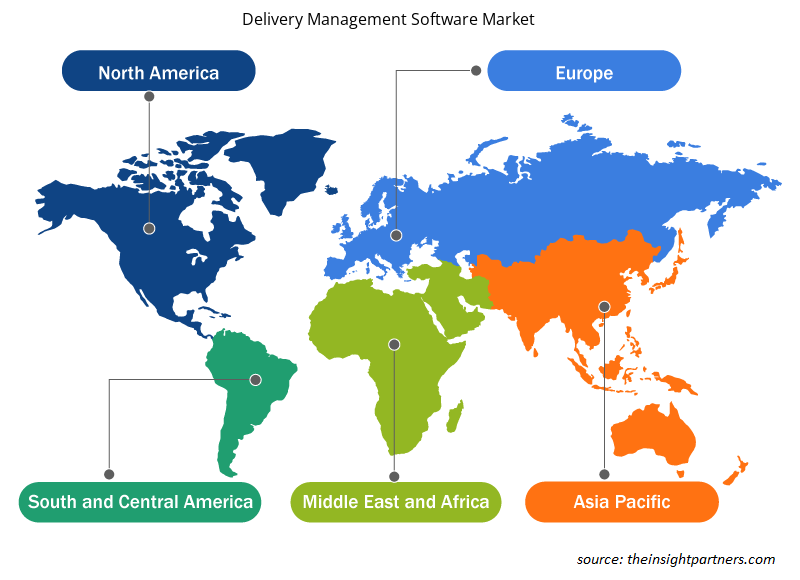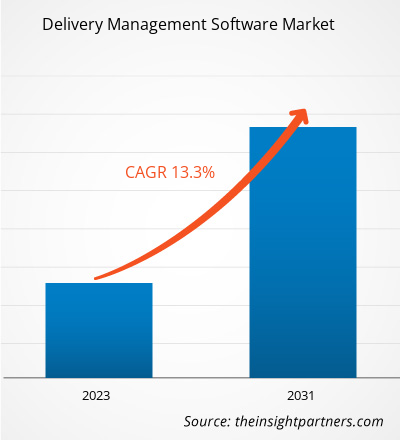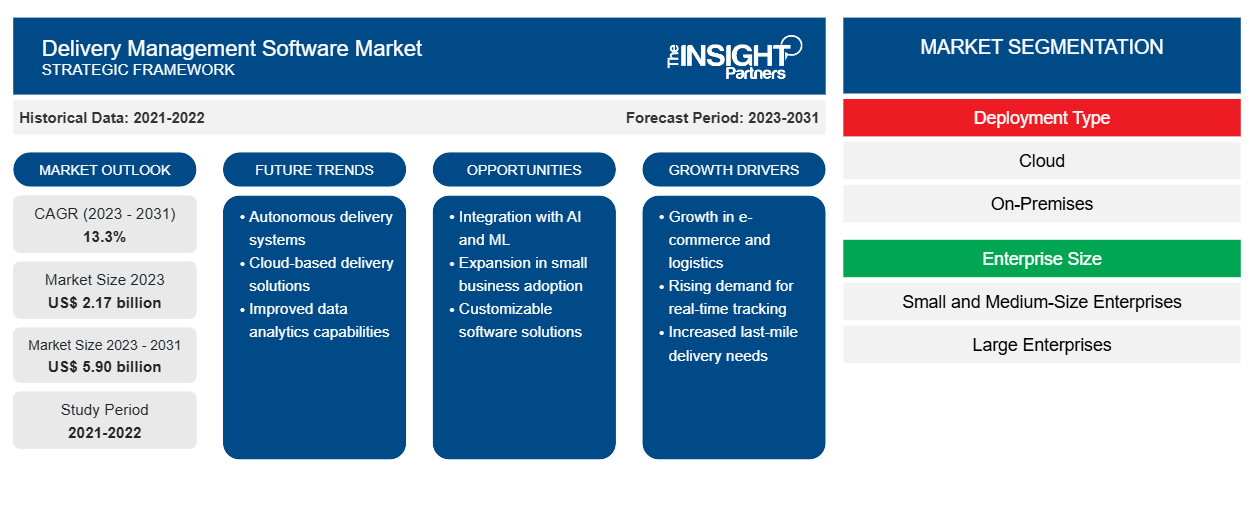交付管理软件市场规模预计将从 2023 年的 21.7 亿美元增至 2031 年的 59.0 亿美元。预计 2023 年至 2031 年期间的复合年增长率为 13.3%。
在交付管理软件中集成人工智能和机器学习技术以增强消费者体验可能会继续成为交付管理软件市场的一个关键趋势。
交付管理软件市场分析
由于电子商务行业的不断扩张以及对管理物流和供应链的实时信息的需求不断增长,配送管理软件市场正在快速增长。受人口增长、数字化程度不断提高以及消费者对网上购物的偏好推动,市场正在稳步扩张。此外,终端用户对自动化的需求不断增长,为市场增长提供了有利可图的机会。
交付管理软件市场概览
配送管理软件用于跟踪货物并确保及时将物品送达客户。使用创新的配送管理软件可为企业带来显著优势,包括提高资产利用率、提高客户满意度和降低燃料使用量。该软件将送货司机和后端办公室连接到一个平台上,并提供司机送货所需的信息。对实时信息和改进的配送跟踪的需求不断增长,推动了市场的发展。
定制此报告以满足您的需求
您可以免费定制任何报告,包括本报告的部分内容、国家级分析、Excel 数据包,以及为初创企业和大学提供优惠和折扣
-
获取此报告的关键市场趋势。这个免费样品将包括数据分析,从市场趋势到估计和预测。
交付管理软件市场驱动因素和机遇
电子商务行业不断扩张,推动市场发展
电子商务行业的不断扩张和消费者对最后一英里送货服务日益增长的需求正在推动市场的发展。电子商务业务正在全球范围内迅速扩张,因为越来越多的消费者选择网上购物作为一种便捷的选择。这导致消费者对送货服务的需求激增,尤其是最后一英里送货。最后一英里送货是电子商务业务的重要组成部分。它涉及将商品从仓库运输到客户家门口。电子商务企业专注于确保他们的商品快速、经济高效地送达客户,这增加了企业对送货管理软件的需求。然而,电子商务行业的扩张和消费者对网上购物的偏好转变正在推动市场的发展。
最终用户对自动化的需求不断增长——交付管理软件市场的机会
尖端技术的出现为配送管理软件市场带来了可观的增长潜力。配送管理软件市场的大型企业正在大力投资采用人工智能和机器学习技术来实现配送流程的自动化。此外,自动化通过支持企业改善订单履行和配送程序,在配送管理中获得了极大的关注。自动化可帮助餐厅配送、物流、快递业务等最终用户简化流程、降低成本并改善客户体验。物流公司高度采用路线优化、自助服务门户和自动化配送等多种自动化技术,以实现更快、更有效的产品配送。
交付管理软件市场报告细分分析
有助于得出交付管理软件市场分析的关键部分是部署类型、企业规模和最终用户。
- 根据部署类型,交付管理软件市场分为云和本地。云部分在 2023 年占据了更大的市场份额。
- 从企业规模来看,交付管理软件市场分为中小型企业和大型企业。大型企业在 2023 年占据了更大的市场份额。
- 根据最终用户,市场细分为餐厅配送、物流、快递业务等。物流部门在 2023 年占据了最大的市场份额。
交付管理软件市场份额(按地区)分析
交付管理软件市场报告的地理范围主要分为五个区域:北美、亚太、欧洲、中东和非洲、南美/南美和中美。
就收入而言,亚太地区占据了最大的配送管理软件市场份额,电子商务领域不断扩大、人口不断增长以及消费者对网上购物的偏好。企业对配送管理软件的需求不断增加,以通过降低额外的物流成本来简化配送流程,这些因素正在推动市场的发展。此外,技术进步和对用于适当管理产品配送的基于云的软件的需求不断增加,正在为市场创造机会。
交付管理软件市场新闻和最新发展
交付管理软件市场通过收集主要和次要研究后的定性和定量数据进行评估,其中包括重要的公司出版物、协会数据和数据库。以下是交付管理软件和策略市场的发展列表:
- 2024 年 2 月,Inspire Brands 收购了“Vromo”,以简化配送渠道。Vromo 是一款在线食品配送软件,通过为最终客户提供配送跟踪服务,支持 Inspire Brands 运营配送流程。(来源:Inspire Brands,新闻稿,2024 年)
交付管理软件市场区域洞察
Insight Partners 的分析师已详尽解释了预测期内影响交付管理软件市场的区域趋势和因素。本节还讨论了北美、欧洲、亚太地区、中东和非洲以及南美和中美洲的交付管理软件市场细分和地理位置。

- 获取交付管理软件市场的区域特定数据
交付管理软件市场报告范围
| 报告属性 | 细节 |
|---|---|
| 2023 年的市场规模 | 21.7亿美元 |
| 2031 年市场规模 | 59亿美元 |
| 全球复合年增长率(2023 - 2031) | 13.3% |
| 史料 | 2021-2022 |
| 预测期 | 2023-2031 |
| 涵盖的领域 |
按部署类型
|
| 覆盖地区和国家 |
北美
|
| 市场领导者和主要公司简介 |
|
交付管理软件市场参与者密度:了解其对业务动态的影响
交付管理软件市场正在快速增长,这得益于最终用户需求的不断增长,而这些需求又源于消费者偏好的不断变化、技术进步以及对产品优势的认识不断提高等因素。随着需求的增加,企业正在扩大其产品范围,进行创新以满足消费者的需求,并利用新兴趋势,从而进一步推动市场增长。
市场参与者密度是指在特定市场或行业内运营的企业或公司的分布情况。它表明在给定市场空间中,相对于其规模或总市场价值,有多少竞争对手(市场参与者)存在。
在交付管理软件市场运营的主要公司有:
- 德利福科技私人有限公司
- FarEye(RoboticWares 私人有限公司)
- 捷斯威有限公司
- 丛林工坊
- Loginext Solutions Private Limited
- Mobisoft 信息技术有限公司
免责声明:上面列出的公司没有按照任何特定顺序排列。

- 获取交付管理软件市场顶级关键参与者概述
交付管理软件市场报告范围和交付成果
“交付管理软件市场规模和预测(2023-2031)”报告对市场进行了详细分析,涵盖以下领域:
- 范围内涵盖的所有主要细分市场的全球、区域和国家层面的市场规模和预测
- 市场动态,如驱动因素、限制因素和关键机遇
- 未来的主要趋势
- 详细的 PEST/波特五力分析和 SWOT 分析
- 全球和区域市场分析涵盖关键市场趋势、主要参与者、法规和最新市场发展
- 行业格局和竞争分析,涵盖市场集中度、热点图分析、知名参与者和最新发展
- 详细的公司简介
- 历史分析(2 年)、基准年、预测(7 年)及复合年增长率
- PEST和SWOT分析
- 市场规模、价值/数量 - 全球、区域、国家
- 行业和竞争格局
- Excel 数据集
近期报告
相关报告
客户评价
购买理由
- 明智的决策
- 了解市场动态
- 竞争分析
- 客户洞察
- 市场预测
- 风险规避
- 战略规划
- 投资论证
- 识别新兴市场
- 优化营销策略
- 提升运营效率
- 顺应监管趋势























 获取免费样品 - 交付管理软件市场
获取免费样品 - 交付管理软件市场